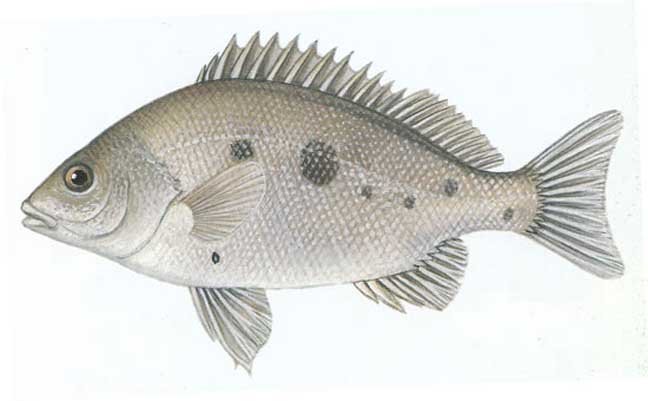Leathery Grunter, Scortum hillii (Castelnau 1878)

Leathery Grunter, Scortum hillii. Source: Jill Ruse. License: all rights reserved
Leathery Grunter, Scortum hillii (Castelnau 1878)
More Info
|
Distribution |
Known only from from the Fitzroy River system, QLD; a tropical species inhabiting flowing freshwater streams and still pools in clear or turbid water with temperatures between 12 and 35ºC; also occurs in estuaries. |
|
Features |
Meristic features: Dorsal fin XIII, 11-13; Anal fin III, 8-10; Pectoral fin 15-17; Pelvic fin I, 5; Lateral line 50-62; Transverse scales 11-13/1/22-28; Gill rakers 8-13+1+16-26; Vertbrae 11+14. Body moderately deep, 2.5-3.0 in SL, ovate, slightly compressed, more so in adults; dorsal profile much more pronounced than ventral in juveniles, only slightly more in adults, nearly straight from snout in interorbital region, concave above eyes, then convex to dorsal origin; dorsal profile of adults straighter overall; ventral profile straight from lower jaw to anus in young, gently curved in adults; more pronounced in larger specimens. Head length 3.05-3.5 in SL. Snout blunt, more so in adults. Nostrils separated by a distance equal to diameter of posterior nostril. Eye width 3.5-5.7 in HL. Jaws equal, length 3.4-4.5 in HL; gape oblique; maxillary reaching to vertical through posterior nostril or anterior of eye; teeth partially flattened, depressible; in bands with outer row enlarged; teeth variably present on vomers in adults, lacking on palatines. Lacrimal serrate; strongly in young; serrations obscure or lacking in larger individuals. Preoperculum serrate; serrations stronger on angle and vertical edge; becoming weaker with age. Lower opercular spine stronger and longer; not extending beyond edge of opercular lobe. Posttemporal exposed; posterior edge serrate. Cleithrum exposed; posterior edge serrate; serrations weaker with age; scales on side. Supracleithrum exposed. Scales relatively small, finely ctenoid; lateral line continuous, smoothly curved; 3-5 scales on caudal; 14-18 predorsal scales to occiput; 2 rows of scales in sheath at base of dorsal fin, sheath extending to fourth or fifth dorsal ray; 3-4 rows of scales in sheath at base of anal fin, sheath extending to seventh to tenth anal ray; cheek scales in 5-6 rows; 63-71 scales in a series above lateral line; 11-13 scales below the lateral line. Dorsal fin continuous, base 1.6-1.8 in SL; spinous portion arched; first spine short; fifth or sixth longest, 1.7-2.4 in HL, those following decreasing gradually to the penultimate, which is slightly shorter than ultimate, longest dorsal spines longer than longest dorsal rays, longest dorsal ray 2.1-2.5 in HL; soft dorsal rounded. Second anal spine twice as long as first spine, 1.8-2.2 in HL, much longer than third in juveniles, less so in adults where they may be of the same length; longest anal ray 1.6-2.1 in HL, soft anal rounded in young, more angular in adults. Pectoral fins asymmetrically pointed; fourth or fifth rays longest. Ventral fins pointed; first ray longest, slightly filamentous; reaching three-quarters of distance to anus. Caudal fin emarginate. |
|
Size |
To 35 cm SL, commonly to 25 cm. |
|
Colour |
Body olive or grayish on back and sides, with irregular spots of varying size and position on sides; much paler overall in juveniles. Head darker above, pale below, without any prominent markings. Spinous portion of dorsal fin uniformly dusky; paler in young; soft dorsal dusky with paler edge and dark basal blotch. Caudal fin uniformly dusky, darker in adults. Pectoral fins dusky; more heavily pigmented at base. Pelvic fins dusky. |
|
Feeding |
Omnivore - feeds mostly on mussels and algae. |
|
Biology |
Oviparous, migrating upstream to spawn during summer when water levels rise. |
|
Etymology |
The species is named hillii in honour of Mr. Hill, former director of the Brisbane Botanical Gardens. |
|
Species Citation |
Therapon hilli Castelnau, 1878, Proc. Linn. Soc. N.S.W. (1)2(3): 226. Type locality: Dawson River, Taroom, QLD. |
|
Author |
Martin F. Gomon |
Leathery Grunter, Scortum hillii (Castelnau 1878)
References
Allen, G.R., Midgley, S.H. & Allen, M. (2002). Field guide to the freshwater fishes of Australia. Perth : Western Australian Museum 394 pp.
Castelnau, F.L. de (1878). Australian fishes, new or little known species. Proc. Linn. Soc. N.S.W. (1)2(3): 225–248 pls 1–2
Grant, E.M. (1975). Guide to Fishes. Brisbane : Co-ordinator-General Department 3rd Edn 640 pp. (as Therapon hillii).
Grant, E.M. (2002). Guide to Fishes. Redcliffe : E.M. Grant Pty. Limited 9th Edn 880 pp.
Vari, R.P. (1978). The terapon perches (Percoidei, Terapontidae) a cladistic analysis and taxonomic revision. Bull. Amer. Mus. Nat. Hist. 159(5): 175–340 figs 1–94.
Wager, R. 1996. Scortum hillii. In: IUCN 2013. IUCN Red List of Threatened Species. Version 2013.1. <www.iucnredlist.org>. Downloaded on 25 September 2013

